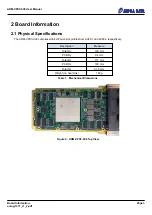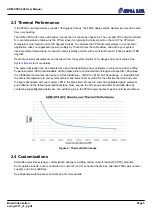
ADM-VPX3-9V2 User Manual
2.3 Thermal Performance
If the FPGA core temperature exceeds 105 degrees Celsius, the FPGA design will be cleared to prevent the card
from over-heating.
The ADM-VPX3-9V2 comes with either a convection or conduction heat sink. The only part of the card monitored
for over-temperature shutdown is the FPGA, since it is typically the hottest point on the card. The FPGA die
temperature must remain under 100 degrees Celsius. To calculate the FPGA die temperature in a convection
application, take your application power, multiply by Theta JA from the table below, and add to your system
internal ambient temperature. Conduction cards typically perform with a constant theta JC (chassis wall) of TBD
degC/W.
Real time power measurements can be taken from the system monitor 12V voltage and current values. See
for more details.
The power dissipation can be estimated by using the Alpha Data power estimator in conjunction with the Xilinx
Power Estimator (XPE) downloadable at http://www.xilinx.com/products/technology/power/xpe.html. Download
the UltraScale tool and set the device to Virtex Ult, VU9P or VU13P, B2104 package, -2, Industrial. Set
the ambient temperature to your system ambient and select 'user override' for the effective theta JA and enter
the figure associated with your system LFM in the blank field. Proceed to enter all applicable design elements
and utilization in the following spreadsheet tabs. Next, acquire the 9V2 power estimator from Alpha Data by
contacting [email protected]. You will then plug in the FPGA power figures to get a board level estimate.
Figure 3 : Thermal Performance
2.4 Customizations
Alpha Data provides extensive customization options to existing commercial off-the-shelf (COTS) products.
Some options include, but are not limited to: custom Front IO, enhanced heat sinks, alternate FPGA part number
support, and circuit additions.
See https://www.alpha-data.com/mcots.php for more details.
Page 5
Board Information
ad-ug-1377_v1_2.pdf









































